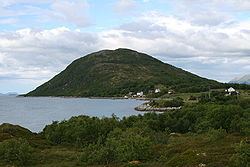Country Norway District Central Hålogaland Area rank 205 in Norway Area 512.8 km² Population 3,025 (2012) | County Troms Administrative centre Borkenes Demonym(s) Kvæfjerding Local time Sunday 12:40 PM Official language form Norwegian Language | |
 | ||
Weather -9°C, Wind S at 11 km/h, 77% Humidity Points of interest Trastad Collections, Hemmestad Wharf, Stranda, Strand, Vassvika, Lyngen, Brurstranda | ||
Kvæfjord (Northern Sami: Giehtavuotna) is a municipality in Troms county, Norway. It is part of the traditional region of Central Hålogaland. The administrative centre of the municipality is the village of Borkenes. Other villages include Hundstad, Langvassbukta, and Revsnes.
Contents
- Map of KvC3A6fjord Municipality Norway
- General information
- Name
- Coat of arms
- Churches
- Economy
- Geography
- Government
- Municipal council
- References
Map of Kv%C3%A6fjord Municipality, Norway
Together with Harstad, the two municipalities cover a large part of the island of Hinnøya in the southern part of the Troms county. Kvæfjord consists mostly of mountains and fjords. The municipality centers on the Kvæfjorden and Gullesfjorden.
Kvæfjord is also where the Norwegian national cake originally comes from.
General information
Kvæfjord was established as a municipality on 1 January 1838 (see formannskapsdistrikt). On 25 October 1956, a part of Kvæfjord (population: 32) was transferred to neighboring Trondenes municipality. On 1 January 2000, the part of Kvæfjord that surrounded the Godfjorden (population: 102) was transferred from Kvæfjord to Sortland municipality (in neighboring Nordland county).
Name
The municipality is named after the fjord (Old Norse: Kviðjufjǫrðr). The first element is the genitive case of the name of the island Kviðja (now Kvæøya) and the last element is fjǫrðr which means "fjord". The name of the island might be derived from the word kviðr which means "belly" or "stomach". Prior to 1889, the name was spelled Kvædfjord.
Coat-of-arms
The coat-of-arms is from modern times. They were granted on 4 April 1986. The arms show a strawberry plant. The main source of income in the municipality is agriculture, and it is also the northernmost village in Norway where strawberries can grow.
Churches
The Church of Norway has one parish (sokn) within the municipality of Kvæfjord. It is part of the Trondenes deanery in the Diocese of Nord-Hålogaland.
Economy
The municipality is known for agriculture and farming. The quality of the strawberries is famous. The long hours of daylight, combined with relatively low summer temperatures, make the strawberries more tasteful than berries grown in warmer climates.
A large institution for the mentally handicapped was once located in Kvæfjord. It employed a large number of health workers.
Geography
The municipality is located on Hinnøya island and it is split by three smaller branches of the large Andfjorden: Gullesfjorden, Kvæfjorden, and Godfjorden. The island of Kvæøya is located in the middle of the Kvæfjorden, across from Borkenes.
The landscape of today was largely formed during the last ice age. When the ice retreated, the terrain rose by 50 metres (164 ft). It is in this belt of old seabed that today's best farm land is located. There are four county roads connecting the municipality: two to the north and one each to the east and south. The 412-metre (1,352 ft) tall mountain Nupen is located in the northern part of the municipality on the border with Harstad.
Government
All municipalities in Norway, including Kvæfjord, are responsible for primary education (through 10th grade), outpatient health services, senior citizen services, unemployment and other social services, zoning, economic development, and municipal roads. The municipality is governed by a municipal council of elected representatives, which in turn elect a mayor.
Municipal council
The municipal council (Kommunestyre) of Kvæfjord is made up of 23 representatives that are elected to every four years. Currently, the party breakdown is as follows:
